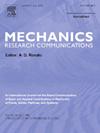可压缩麦克斯韦流体的加速度波分析
IF 2.3
4区 工程技术
Q3 MECHANICS
引用次数: 0
摘要
建立了可压缩麦克斯韦粘弹性流体的加速度波分析方法。还考虑了修正的麦克斯韦流体模型。分析了在三维空间中运动的二维不连续面加速度波。发现纵波可以传播,但麦克斯韦模型也允许横波传播。波速是明确计算出来的。计算了沿固定方向运动的平面波的振幅,并与无粘流体中的类似振幅进行了比较。本文章由计算机程序翻译,如有差异,请以英文原文为准。
Acceleration wave analysis for a compressible Maxwell fluid
An acceleration wave analysis is developed for a Maxwell viscoelastic fluid which is compressible. A revised Maxwell fluid model is also considered. A two-dimensional discontinuity surface which is an acceleration wave is analysed moving in three-dimensional space. It is found that a longitudinal wave may propagate, but the Maxwell model also allows for a transverse wave. The wavespeeds are calculated explicitly. The wave amplitude is calculated for a plane wave moving in a fixed direction and the amplitude is compared with the analogous one in an inviscid fluid.
求助全文
通过发布文献求助,成功后即可免费获取论文全文。
去求助
来源期刊
CiteScore
4.10
自引率
4.20%
发文量
114
审稿时长
9 months
期刊介绍:
Mechanics Research Communications publishes, as rapidly as possible, peer-reviewed manuscripts of high standards but restricted length. It aims to provide:
• a fast means of communication
• an exchange of ideas among workers in mechanics
• an effective method of bringing new results quickly to the public
• an informal vehicle for the discussion
• of ideas that may still be in the formative stages
The field of Mechanics will be understood to encompass the behavior of continua, fluids, solids, particles and their mixtures. Submissions must contain a strong, novel contribution to the field of mechanics, and ideally should be focused on current issues in the field involving theoretical, experimental and/or applied research, preferably within the broad expertise encompassed by the Board of Associate Editors. Deviations from these areas should be discussed in advance with the Editor-in-Chief.

 求助内容:
求助内容: 应助结果提醒方式:
应助结果提醒方式:


